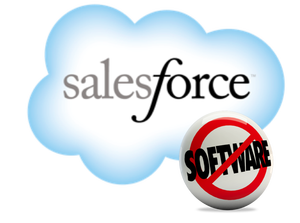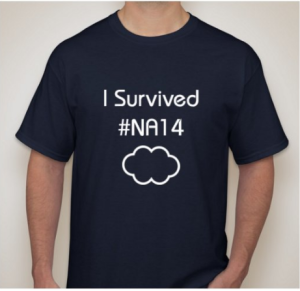Can We Trust Salesforce for Business in the Cloud?
I have been meaning to write about Salesforce since its Dreamforce 2015 conference. Salesforce provides a platform, tools and applications for business and IT who claims to be the ‘no software’ company which as you will read is exactly what happened on May 10th. Heck, Salesforce is making a lot of advances on its platform, its applications and even with Analytics and the Internet of Things. These changes are at the center of what at our analyst firm calls digital business innovation. Much of what it’s doing is very good, but now I am questioning whether the company’s foundation of business processes and technology platform has reached a point at which it can’t grow any further without impacting its own customers’ operations and success. That may be a harsh statement, but I think my reasoning will become clear as you read this perspective.
This is not my usual focus, but it comes from a customer-centric perspective since we have been a customer of Salesforce since 2012. You’ll find this is different from most of my analyst perspectives, which take the approach of a technology insider; after all, as an industry analyst in 2011 I was the top-rated enterprise software analyst (if you don’t mind a little self-promotion). In this case, however, I won’t go into the research and best practices that show what Salesforce needs to do to be an effective provider of CRM and other business tools that help companies succeed in serving their customers and delivering the best possible overall experience.
The stimulus for this piece was something that caught the whole industry’s attention: the all-day #NA14 outage on May 10, 2016. What is #NA14? Organizations that rent Salesforce applications that are housed and served from the #NA14 cluster of servers (one of 37 clusters around North America) know what it is. On that date it experienced what I believe was the largest-scale outage in Salesforce’s history and maybe ever in the industry based on number of companies and users. While other clusters also had some shorter outages at the same data centers, it was #NA14 that went out for the entire day. So impactful that the humor of having a t-shirt that those affected can purchase.
 You might say, it was just one day, so what is the big deal? Well, thousands of companies that have hundreds or thousands of users each were abruptly denied access to their applications for marketing, sales, customer service, messaging and to analytics and any custom applications and all their interactions with prospects and customers. This means everything was down, and for businesses that operate on Salesforce’s platform – like ours does – across marketing, sales, customer service, operations, customer engagement and even accounting, this was a major inconvenience. Much of the #NA14 fiasco has been documented and reported by Information Week and eWeek. As well as the outage, customers lost five hours of data (according to their Salesforce Trust website) and I can imagine at least millions of dollars in worker productivity and potential new sales. The customer interactions that could not occur had a direct impact on the customer experience that companies were trying to deliver, and you can bet those customers were not happy.
You might say, it was just one day, so what is the big deal? Well, thousands of companies that have hundreds or thousands of users each were abruptly denied access to their applications for marketing, sales, customer service, messaging and to analytics and any custom applications and all their interactions with prospects and customers. This means everything was down, and for businesses that operate on Salesforce’s platform – like ours does – across marketing, sales, customer service, operations, customer engagement and even accounting, this was a major inconvenience. Much of the #NA14 fiasco has been documented and reported by Information Week and eWeek. As well as the outage, customers lost five hours of data (according to their Salesforce Trust website) and I can imagine at least millions of dollars in worker productivity and potential new sales. The customer interactions that could not occur had a direct impact on the customer experience that companies were trying to deliver, and you can bet those customers were not happy.
Making it even worse, Salesforce did not substantively communicate to customers and users while all business using Salesforce was at a complete standstill. The company did nothing to relieve the internal confusion and panicky communications within organizations that wanted to know what was going on.
Why this lack of communication? After a little investigation I found that the customer information Salesforce needed to communicate with its customers resides on the same servers that were offline and so was inaccessible to the Salesforce account and customer service teams! This means that Salesforce does not have a centralized customer information store that is a replica or master of the data stored on its server clusters around the world. How is this possible for a company of its size and reputation? A lack of investment in process and infrastructure that has led to a brittle foundation for its cloud computing empire must be at the root of the situation. Any organization that depends on customer relationships should have its customer information available even when key software is not operational and should know how to communicate to its customers across any channel, voice, text or email. My colleague Richard Snow outlined this in his guidance for 2016, and Salesforce should heed his advice and apply what he has written about the innovations it provides to its customers to its own business. When I look at the information Salesforce has about our organization, I see that it does not have fields to tell them how they should communicate urgent notifications and by what channel. Would it be most useful to call, text or email? Here are some serious places for improvement.
Salesforce eventually got past its consistently uninformative responses on Twitter to check its trust.salesforce.com site. CEO Marc Benioff personally replied to some people’s tweets like mine with this: “I am sorry for our service disruption on NA14, please email me at ceo@salesforce.com so we can call you @parkerharris.” It revealed that the company does not link Twitter handles to customers and store centrally. The Twitter mob launched a flood of obnoxious, sometimes hilarious memes on the situation, like pictured here, and very quickly it became too late for Salesforce to recover. I did email and tried to follow up with Marc but got no response, so that gesture on his part was worse than nothing. I got basic responses to direct messages on Twitter but nothing that improved my confidence or trust in Salesforce’s ability to resolve the situation.
Something that was not mentioned at all during this service disruption and data loss is that Salesforce uses Oracle’s database technology under its Force.com platform. Salesforce stated on its Trust website, “The service disruption was caused by a database failure on the NA14 instance, which introduced a file integrity issue in the NA14 database.” Salesforce was careful not to mention Oracle in any communications, though it noted during the crisis communications that it was a database failure. It is known that Salesforce has built its own abstraction layer as part of its platform, along with its own query interface; maybe that is the root cause of the integrity issues that eventually led to the five hours of data loss. If Salesforce was not able to shift successfully to backup data centers, let alone ensure against a power failure to a data center itself, we wonder whether its data centers are configured properly for fail over and disaster recovery. As a side point it is well known that placing data centers in major metropolitan areas like Chicago and Washington, D.C., is not a best practice; Google, Facebook and others have selected locations in Oregon that are remote and geographically stable and have lower energy costs and less risk of failure for power or human mistakes.
During the crisis, individuals at several levels of management in the support and services team tried to salvage the situation, but since Salesforce could not provide real updates online about service restoration, companies were left with their employees who depend on Salesforce sitting around, and many turned to Twitter for laughter. Two days’ later customers received a formal apology letter from Keith Block, Salesforce’s vice chairman, president and COO, that stated that a power distribution failure in a data center forced the company to switch to a backup data center, but there was also a database failure that created file integrity issues that led to the disruption. The letter apologized for the poor quality of service and encouraged companies like ours to contact him or our account team or even file a support ticket, which showed some humility. But it did not mention the lost five hours of data that was acknowledged on its Trust website, so you would have to do your own investigation to determine whether you had data being entered during that time. And no reference in the email or direction communications to customers that “#NA14 instance continues to operate in a degraded state that can impact the reliability from a performance and scalability perspective, or that they are planning a four-hour shutdown on Sunday, May 15th to attempt to do what they have stated as “bring the NA14 instance back to full functionality”. I guess that customer communication on the operations of its applications and software is still not a priority for Salesforce and making customers go and check the website is what they believe is a great customer experience.
What would you do to make up for a #NA14 situation if this was your company? I probably would offer incentives for future services or even apology incentives in the form of gift cards for every user – something to show you care about the customer experience beyond an apology letter that does nothing to help individuals who are on performance plans for quotas to customer engagement interactions. And the email was followed up by another email inviting customers of #NA14 to a special executive team conference call to probably further apologize on the situation. If I was any customer of Salesforce, I would want to be listening to this phone call and communications from executives to determine what might happen to them. Let’s hope that the time since the #NA14 crash has placed a level of seriousness and reconciliation with Salesforce executives.
All of this comes back to the overall customer experience in subscribing to software from Salesforce. Salesforce has become difficult to work with for businesses, especially small and midsize ones. Our own business made three changes to our subscription over the last 9 months to upgrade and purchase more licenses – changes that it should be simple and straightforward to make. But if you have experienced the Salesforce Checkout, you know it is anything but pleasant to review quotes, contracts, orders, statements and invoices, and the billing and payment system is even worse. You cannot pay for your subscribed changes by credit card and ACH like you can with any other software as a service on the Internet from, say, Microsoft, Adobe or even SAP or the range of services that a business pays for in healthcare, insurance, contractors and online banking. Salesforce asks you to mail a check because it is more expensive for it to provide online payment. Really? This is the most inefficient way to conduct commerce and make payments. When we refused to pay by check, Salesforce collections generated a new invoice with ACH/Wire information that a customer can manually use; but I refused to waste my company time and I called collections who took my credit card number over the phone. The company at this point doesn’t have an online payment system managed by the customer as is standard in the industry.
Even worse, communications to customers come from what is called the collections department, which is an insulting word, as if you were a deadbeat; why not call this team Customer Payment? My experience in three incidents suggests this team needs training in effective customer communications to maintain a quality customer experience. Salesforce’s customer engagement approach for requesting and paying for software is ludicrous, and it comes from a company that markets itself as providing a “customer success platform empowering companies to connect with their customers in a whole new way” – that’s in the About Salesforce statement in its press releases and website, and it could not be further from the truth when it comes to the experience it actually provides to customers. All of this could be fixed by using subscription and recurring revenue software from Salesforce’s partners and ensure the focus is on the subscriber experience like its partner Zuora provides today, and as Richard Snow has pointed out.
Another nagging issue stands as the largest impediment for companies that try to gain access to the latest innovations from Salesforce. I mean its new user experience, Salesforce Lightning. It was announced to customers in 2014 and begun to be released in 2015, but it is still not widely used. I have learned that thousands of companies have yet to migrate to Lightning as organizations have determined it is not ready for prime time in large and small deployments. Our experience has been that it is slow and not responsive to quick changes in the layout of information you are viewing and for getting to previous functionality requires switching to the classic interface. Plus not all of the entire suite of functionality from Salesforce has been upgraded to support this user experience, including the Console, Contracts, Data.com., Forecasts, Orders and even Getting Started. Yes, that’s right: Salesforce is struggling to get its own new user experience software up and running on all of its own applications, but it insists that it will be pretty much complete by the end of 2016. While this would be a good first step, Salesforce also has yet to make Lightning compatible with Windows Touch, which is now the standard method for the tens of millions of professionals who got a new notebook in the last year to scroll up and down, engage with the application and gesture through information. Today if you try to touch your way through Salesforce, it just does not work like it was turned off or not enabled. My inquiry on the situation to Salesforce found that my assessment was indeed true.
As an analyst firm that covers business applications that relate to the customer experience, from marketing, sales, service and operations all the way to finance, we conclude that Salesforce is not adhering to best practices. Any organization that cannot get access to its customer information to communicate to them in the midst of a crisis because it does not have a centralized customer database is set up to fail. It is a fact that systems will fail, and an organization should be prepared to have centralized backup of all of its customer information. When it comes to communications, an organization should not rely on a condescending top-down approach that some believe is a superhero type effort but be sensitive to how it communicates with customers and be honest in the information within the communication. Salesforce should be sensitive to other communications it is sending out during sensitive times like #NA14. For example, on the day of the #NA14 crash, Salesforce cloud services sent me an email message saying that “simple configuration changes improve business outcomes.” On the following day an email from customersuccessspecialist@salesforce.com invited me to explore how to best utilize my subscription, and this message had been assembled by copying and pasting text with different fonts and sizes of type. How embarrassing. All of which says to me that spinning out communications designed to learn more about me and get me to spend more with Salesforce is more important than my experience with the situation on hand. I had to reach out to our account executive to inquire about the #NA14 crash, but the rep was not able to offer any enlightenment beyond checking the trust.salesforce.com site. In addition we’ve received no communication from the analyst relations group who should be proactively in dialogue with those that recommend and research their company; sadly, that’s not surprising, as getting information or updates on Salesforce is nearly impossible unless you go and find it yourself at Dreamforce.
 Salesforce is investing massively in new real estate for its office towers around the world, and the largest of all is the new headquarters in San Francisco. Being the tallest and reaching into the clouds is a heavily marketed message. I hope that Salesforce is not falling victim to what my colleague Robert Kugel calls the headquarters effect. Unfortunately the reality of a cloud infrastructure is that it still operates on Planet Earth, and Salesforce needs to pay significant attention to that. I have pointed out issues in Salesforce’s cloud computing approach – in its processes, technology and people – that make it more difficult to work with from my viewpoint than hundreds of other technology providers. To provide customer relationship management (CRM), which is the stock ticker (NYSE:CRM) of Salesforce, how the processes are instrumented and people are empowered and enabled to communicate is more important than the technology itself.
Salesforce is investing massively in new real estate for its office towers around the world, and the largest of all is the new headquarters in San Francisco. Being the tallest and reaching into the clouds is a heavily marketed message. I hope that Salesforce is not falling victim to what my colleague Robert Kugel calls the headquarters effect. Unfortunately the reality of a cloud infrastructure is that it still operates on Planet Earth, and Salesforce needs to pay significant attention to that. I have pointed out issues in Salesforce’s cloud computing approach – in its processes, technology and people – that make it more difficult to work with from my viewpoint than hundreds of other technology providers. To provide customer relationship management (CRM), which is the stock ticker (NYSE:CRM) of Salesforce, how the processes are instrumented and people are empowered and enabled to communicate is more important than the technology itself.
I hope Salesforce will assess its people, processes, information and technology to ensure it can deliver the great customer experience that it espouses as the main value in working with it. From our point of view, as Robert Kugel has written on Salesforce and midsize company opportunity, it is clear that depending too much on one provider may not be the best recipe for success. Even Salesforce is rumored to be shifting away from its own cloud computing environment for its Internet of Things (IoT) and will operate on Amazon Web Services (AWS). Our organization is reassessing whether Salesforce is the right provider to support our marketing, sales, service, operations and customer management for the future. In addition, over the coming months we as analysts will assess Salesforce’s advances in marketing, sales, service, analytics and platform and write about them to help you make your own decisions on whether to reassess or invest with Salesforce for your future in the cloud. It is a serious question whether this company can be trusted to effectively support the business success of its users and customers and whether it can rebuild confidence that it can respond to the critical situations that happen to any technology provider.
Is Salesforce able to communicate with and engage customers for the best possible experience? Can Salesforce listen to its customers and improve their product as I have pointed out? Will it improve its business communications to its customers? Time will tell what Salesforce does and how it will recover from #NA14 and prepare itself for the future and how it communicates its plans to mitigate the risk of similar failures in the future.
Regards,
Mark Smith
CEO and Chief Research Officer
Authors:

Mark Smith
Partner, Head of Software Research
Mark Smith is the Partner, Head of Software Research at ISG and Ventana Research leading the global market agenda as a subject matter expert in digital business and enterprise software. Mark is a digital technology enthusiast using market research and insights to educate and inspire enterprises, software and service providers.










